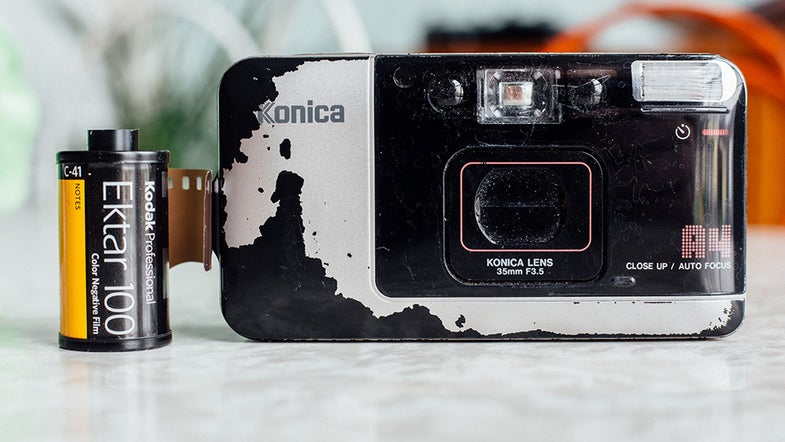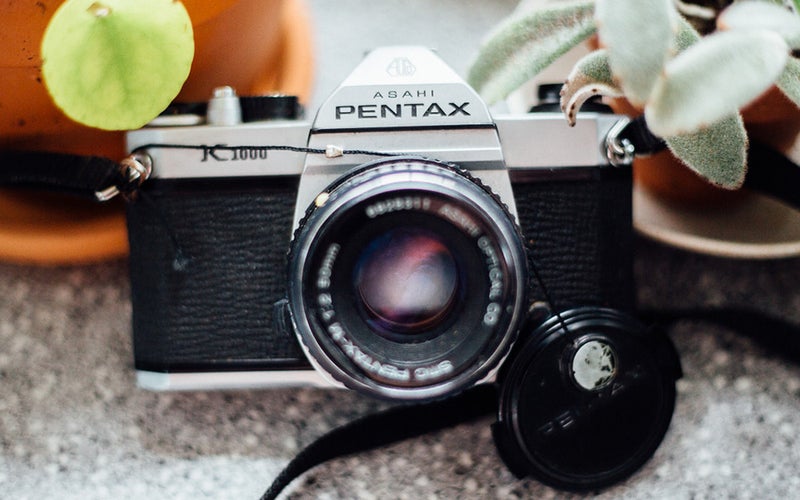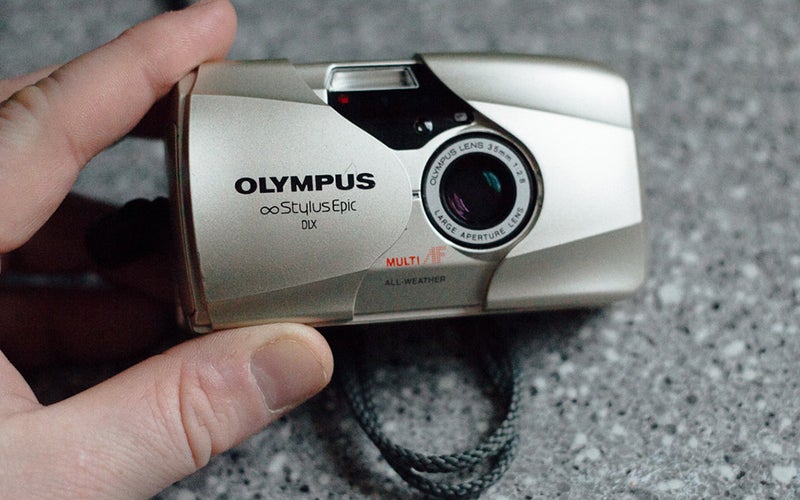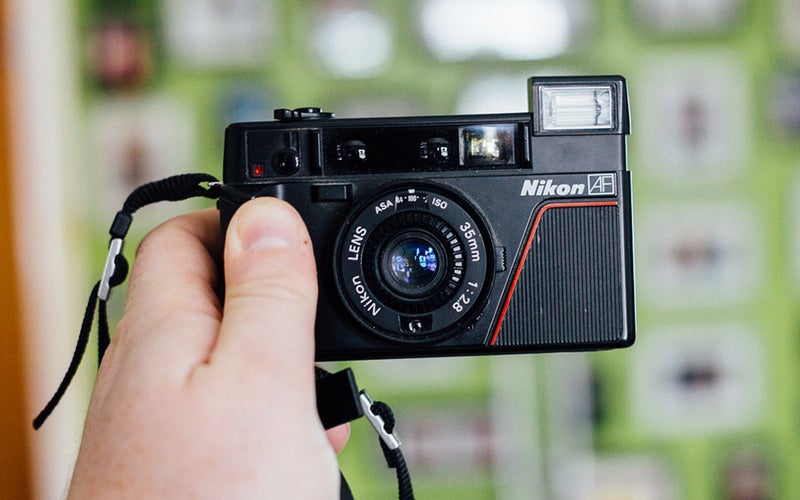A normal person’s guide to buying an old film camera
You don't have be an expert (or a hipster) to enjoy analog photography.

We may earn revenue from the products available on this page and participate in affiliate programs. Learn more ›
Stan Horaczek
Kodak recently announced it was bringing back one of its iconic black-and-white films, TMax P3200, which has been out of production since 2012. It’s a monochrome film that’s extra-sensitive to light, so you can shoot with it in dark settings, and it will give you a gritty, grimy look that so many smartphone filter apps have tried to replicate. But that’s not the only good news in the film photography world at the moment. Kodak is still preparing another iconic film called Ektachrome for market later this year, and a new film SLR from a company called Reflex slated to ship later this year camera just had a crowdfunding run that raised 150 percent of its goal.
In short: Right now is a really great time to try out film photography. Of course, it’s not as simple as your smartphone camera, but that’s the point. It’s a process—and that’s a large part of what makes it great.
Of course, the first thing you’ll need is a camera. Luckily, there are still lots of old film shooters waiting to you take you to hipster photography heaven in thrift stores, garage sales, and online auctions. Sadly, this renaissance has pushed prices on the secondary market up from rock bottom a few years ago. But, if you know what to look for, you can find a shooter that will hold its value while churning through roll after roll of cellulose acetate (the material from which film is made).
Pick your perfect old camera
There are three general types of film cameras: SLRs, compacts, and rangefinders. The type you should pick depends on lots of variables including your budget, shooting style, and even aesthetic preferences. If you see something you think you like, check it out on a site like Camerapedia, which offers tons of useful knowledge about old gear.

Nikon F3
SLRs
What are they? This is the classic form factor many people imagine when picturing an analog camera. They have interchangeable lenses in the front and a viewfinder that lets you look out through the lens and into the world with some help from a mirror inside. That’s where they get their three-letter name, which stands for single-lens reflex.
Advantages: SLRs are typically the most durable option and, if you’ve ever used a DSLR (which stands for digital SLR), the whole experience should seem familiar. They typically offer manual controls to help you learn, and you can swap the lenses if you get really into it and want to expand your collection.
If you already have a DSLR from a company like Nikon or Pentax, your lenses might even work (a quick Google search for compatibility will confirm it). If you have a modern Canon camera, however, it’s worth noting that their newer lenses won’t work with older film models.
Disadvantages: They’re the biggest cameras out of all the options, and some older models don’t offer much in the way of assistance when it comes to figuring out exposure, so brush up on your aperture and shutter speed knowledge.
Some models to check out: The Pentax K1000 and the Canon AE-1 Program are both iconic film cameras that are perfect for learning. They were extremely popular, so the companies manufactured millions of them, many of which are still around. I’ve paid as little as $5 for a K1000 at a garage sale. The Minolta SRT-101 is another iconic camera you can find on the cheap, but it’s big and heavy compared to those two.
If you want to step up to a slightly higher-grade camera, the Canon A-1, the Nikon FM2, and the Nikon F3 are also excellent choices. Expect to pay well over $100, and sometimes much more depending on condition, for one of these.
All the SLRs mentioned to this point have been manual focus, which means you have to rotate the lens yourself in order to get things sharp. There are plenty of modern autofocus SLRs out there, but they typically aren’t as affordable as their manual counterparts.
One note about old manual-focus SLRs is that the zoom lenses you sometimes see with them are terrible in terms of build and optical quality. If the camera comes with a big Vivitar, Sears, Quantaray, or another third-party lens, be prepared for soft focus and a clunky user experience. Sticking to a lens that matches the camera’s maker is your safest bet until you learn the intricacies of picking out new glass.
Stan Horaczek
Compact cameras
What are they? They look like black or silver bars of soap, but this segment of the film camera market has taken off over the past two years. They’re also called point-and-shoot cameras, because they don’t offer much in the way of manual controls.
Advantages: If you just want to get the film look without having to learn lots about exposure and other photographic concepts, compacts are a great solution. They’re much smaller than the other types of film cameras, and they often use batteries that are cheaper and easier to find. They’re also conspicuous than a big camera, too.
Disadvantages: Since most compact cameras were designed for mass audiences, many of them are terrible in terms of image quality and build. Again, they don’t offer much in the way of manual controls, which may be a negative depending on your outlook. Also, because of the way their lenses are constructed, they often have to rely on the built-in flash to get the proper amount of light in the photo. Shooting a flash in 2018 immediately draws a lot of attention. You also can’t change lenses if you get sick of the same field of view.
Some models to consider Unfortunately, the demand for any truly excellent compact cameras has spiked hard over the past year or so, thanks in part to their stylish nature. Kylie Jenner, for instance, recently touted the virtues of her Contax T2 (a truly iconic camera), and the average price on the second-hand market spiked several hundred dollars to around $1,000.
Olympus made some excellent point-and-shoot cameras under the Stylus series, and the zoom lens versions are still pretty affordable at less than $100. There’s another version called the Stylus Epic (or the international name, the MJU II), which has an exceptionally sharp lens, and doesn’t zoom. It’s getting more difficult to find them all the time for anything below $200.
If you go thrifting, keep an eye out for pretty much anything made by Contax, Olympus Stylus compacts, or anything in the Ricoh GR family.
If you don’t want to go bargain hunting or drop hundreds of dollars, the Nikon L35AF, which you can often find at estate sales and on eBay for under $100, is an underrated camera that’s bigger than most point-and-shoots, but has a great lens attached.

Minolta Easy Flash Camera
Rangefinders
What are they? The rangefinder resides somewhere between the compact and the SLR. You compose and focus using a viewfinder held up to your eye, but you don’t actually see through the lens of the camera, as you would with an SLR. The lens is coupled to the viewfinder so it knows when something is in focus. Shooting with a rangefinder is likely different than anything you’ve experienced with a digital camera, unless you’ve used something like the Fujifilm X100F. Try it before you make the leap.
Advantages: Some rangefinders allow you to swap out your lenses, while others opt for a fixed lens system that tunes the glass for that specific camera. They’re typically smaller than SLRs, but offer more manual controls than a compact. They’re also often some of the best-looking cameras around.
Disadvantages: The focusing process will likely take a little getting used to. The good ones are fairly expensive. Many of the older models don’t have a built-in light meter, so you’ll have to get a separate one or use a digital camera as a benchmark.
Some models to consider The Leica M series is often considered the gold standard against which all other rangefinders are judged. Unfortunately, that means most of them cost absurd amounts of money. A Leica M6, for example (which is desirable because it was the last all-mechanical M camera before the company introduced electronic elements in the M7) typically costs more than $1,000 before you add a similarly pricy lens.
In the world of the more realistic purchases, the Canon QL17 ($25-$100) is a great option for a beginner because it has a very sharp fixed lens. It’s small and relatively easy to use as well. The Yashica Electro 35 ($40-$100) is another good, stylish option.
If you want to get the most out of each roll of film, you can opt for a half-frame rangefinder like the Olympus PEN (roughly $150). It shoots photos that are only half the size of a typical 35-millimeter picture, which means you get 72 images on a single roll that usually only holds 36. You’ll lose some image quality as a trade-off, but if you’re going for the low-fi look, it could actually be a benefit.

Canon Point-and-shoot
Making sure it works
Now that you’ve found a perfect picture machine, it’s time to inspect it and make sure everything is in working order. There’s a chance that any dusty, neglected camera you pick up now has been sitting around for a while unless you get it from a shop—and that can lead to problems.
The first thing to check is the battery compartment. Storing a camera with a battery inside often leads to corrosion, which can literally eat away at the inside of the camera as the acid liberates itself from the cell. If you open the battery door and find green gunk, it’s definitely a warning sign, but it’s not necessarily a dealbreaker. Check and see if the parts look intact and make sure nothing is falling off. If it’s just a little battery gunk, you can typically clean the majority of it with some rubbing alcohol and a cotton swab.
If you have a chance to test out the camera before you purchase it, bring a spare battery with you to try it out. Many newer cameras won’t work at all without a battery inside, so you can’t test to see if you can trigger the shutter with the button. Camera batteries aren’t necessarily easy to find anymore, so don’t be surprised if you have to order one from Amazon or another camera shop after googling which one you’ll need. Typical batteries include CR123 and CR2 cells.
Make sure to try out all the moving parts, as well. If there are knobs, twist them. If the lens has a ring used for focusing, turn it and make sure it doesn’t groan from internal friction (if a lens is making a sound like Chewbacca, it won’t be fun to shoot). If there’s a film advance lever, make sure you can push it, because they often jam up; if it’s frozen, you won’t be able to advance your film.

Konica A4
One crucial element of your new camera is the light meter that measures the illumination in a scene and tells you which settings to use for your shot. Light meters usually engage when you push the camera’s shutter button (the button you use to take the picture) halfway down. When activated, you’ll typically see an indicator through the eyepiece like a needle that fluctuates or a light that moves around an exposure scale to show you what settings to use. Life will be hard if you try to learn without a working light meter, so make sure it’s operational.
Lastly, check the optics. Use your phone’s flashlight to look through the glass of the lens. If you see little tentacle-like streaks inside—especially around the edges—that’s likely lens fungus, which is extremely difficult to remove and might affect your photos, and not in a good, Instagram-filter way. Some lens glass will also yellow as it ages and, which is similarly hard to treat and can add a tinge to your snaps. (If you’re shooting black-and-white film, however, the yellowing is actually less of an issue, for obvious reasons.)
You also might notice a bunch of dust. While that can be annoying, it’s typically harmless. Film cameras employ a focusing screen, which is a piece of glass underneath the viewfinder. It’s often simple to open and clean out the dots of junk. Little bits of dust inside the lens itself are often inconsequential when it comes to image quality, as long as they’re small.
Stan Horaczek
Get some film
By now, you’ve noticed that pretty much every one-hour photo place on the planet has disappeared, which means you should plan on sending your film away for development unless you want to do it yourself (which is totally fun and you should definitely try it, but the subject of a different article!).
If you want to shoot color, start with Agfa Vista (now discontinued), Kodak Gold, or Fuji Superia. They will set you back less than $4 per roll and give you a semi-grainy, and very film-esque look. Expect to pay roughly $11 to have each roll developed and scanned. No, it’s not cheap, but that’s part of what helps the process feel more precious and fun. Labs like The Find Lab and The Darkroom do an excellent job.
If you want to shoot black-and-white, pick up some Kodak T-Max, Kodak Tri-X, or Ilford HP5 (The new TMAX P3200 film from Kodak is aimed at more advanced users since it requires careful processing, which costs extra if you’re sending it out.) All of those stocks have been around forever and there are lots of guides (like ours!) online to help you develop it on your own. You can also send it away to the labs mentioned above, but expect to pay a little more.
Right now, things are relatively great in the film world, but there’s no telling when the boom will end. Film stocks are still going out of production here and there, but it’s easier to shoot film in 2018 than it was five years ago, and that’s a good thing. Let’s hope it lasts.



